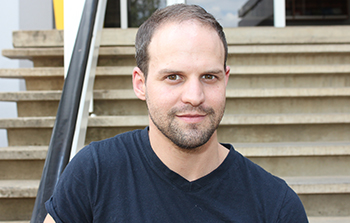
Dr Marthinus Conradie, senior lecturer in the
Department of English, is one of 31 newly-rated National
Research Foundation researchers at the University of
the Free State.
Photo: Rulanzen Martin
Exploring numerous norms and assumptions that impede the investigation of racism and racial inequalities in university classrooms, was central to the scope of the research conducted by Dr Marthinus Conradie, a newly Y-rated National Research Foundation (NRF) researcher.
Support from various colleagues
He is one of 31 newly-rated researchers at the University of the Free State (UFS) and joins the 150 plus researchers at the university who have been rated by the NRF. Dr Conradie specialises in sociolinguistics and cultural studies in the UFS Department of English. “Most of the publications that earned the NRF rating are aimed to contributing a critical race theoretic angle to longstanding debates about how questions surrounding race and racism are raised in classroom contexts,” he said.
Dr Conradie says he is grateful for the support from his colleagues in the Department of English, as well as other members of the Faculty of the Humanities. “Although the NRF rating is assigned to a single person, it is undoubtedly the result of support from a wide range of colleagues, including co-authors Dr Susan Brokensha, Prof Angelique van Niekerk, and Dr Mariza Brooks, as well as our Head of Department, Prof Helene Strauss,” he said.
Should debate be free of emotion?
His ongoing research has not been assigned a title yet, as he and his co-author does not assign titles prior to drafting the final manuscript. “Most, but not all, of the publications included in my application to the NRF draw from discourse analysis of a Foucauldian branch, including discursive psychology,” Dr Conradie says. His research aims to suggest directions and methods for exploring issues about race, racism, and racial equality relating to classroom debates. One thread of this body of work deals with the assumption that classroom debates must exclude emotions. Squandering opportunities to investigate the nature and sources of the emotions provoked by critical literature, might obstruct the discussion of personal histories and experiences of discrimination. “Equally, the demand that educators should control conversations to avoid discomfort might prevent in-depth treatment of broader, structural inequalities that go beyond individual prejudice,” Dr Conradie said. A second stream of research speaks to media representations and cultural capital in advertising discourse. A key example examines the way art from European and American origins are used to imbue commercial brands with connotations of excellence and exclusivity, while references to Africa serve to invoke colonial images of unspoiled landscapes.
A hope to inspire further research
Dr Conradie is hopeful that fellow academics will refine and/or alter the methods he employed, and that they will expand, reinterpret, and challenge his findings with increasing relevance to contemporary concerns, such as the drive towards decolonisation. “When I initially launched the research project (with significant aid from highly accomplished co-authors), the catalogue of existing scholarly works lacked investigations along the particular avenues I aimed to address.”
Dr Conradie said that his future research projects will be shaped by the scholarly and wider social influences he looks to as signposts and from which he hopes to gain guidelines about specific issues in the South African society to which he can make a fruitful contribution.